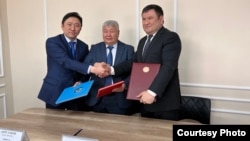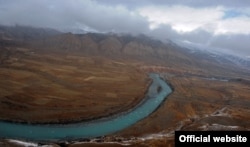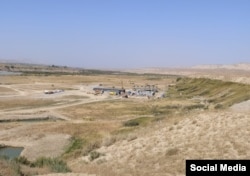ALMATY -- A decade ago, the idea of Kazakhstan and Uzbekistan agreeing to build a giant dam project together with their upstream neighbor Kyrgyzstan would have seemed unimaginable.
Now, a road map agreement signed by the three countries last week to build the dam with a hydroelectric power station on Kyrgyzstan's Naryn River shows that energy and water shortages can bring Central Asian countries together, rather than ripping them apart.
But doubts remain about funding for a $3 billion-plus project that Russia was once expected to oversee and which the trio plans to complete in four years, with construction slated to begin in 2024.
"This project is political," said Azamat Akeneev, an economic expert based in Kyrgyzstan's capital, Bishkek, about Kambar-Ata-1, the hydropower plant in the Jalal-Abad region whose intended capacity is close to 1,900 megawatts. "So the involvement of neighboring countries offers some hope that it will be realized."
The idea to build Kambarata-1, the giant dam that would power the hydroelectric plant at its base, dates back to Soviet times, and it was Moscow that Bishkek turned to in a bid to revive the project in 2008.
Things didn't exactly go according to plan.
At least part of the $300 million soft loan allocated toward the project by Russia went missing, with Russian media pointing the finger at Maksim Bakiev, the son of Kyrgyzstan's then-president, Kurmanbek Bakiev.
After the Bakiev family was ousted in a revolution in 2010, Kyrgyzstan and Russia struck a fresh deal for the dam, as well as several other separate smaller hydropower facilities, also on the Naryn River.
But by 2016, Kyrgyzstan had torn up its contracts with two Russian state-backed companies: Inter RAO, which was overseeing Kambar-Ata-1, and RusHydro, which was set to build the smaller hydropower plants.
Almazbek Atambaev, then the head of state, cited "objective reasons" for Moscow's failure to make real progress on the projects, amid collapsing global energy prices and sanctions imposed on Russia by Western countries over its annexation of Crimea the year before.
"This is going to be the case for a long time…. Kyrgyzstan should exit these agreements and find new investors," Atambaev said at the time.
Some experts speculated that Russia was never much interested in completing the project.
Moscow's main aim, they said, was to acquire leverage over Uzbekistan, with whom the Kremlin's relations had cooled, and which was virulently opposed to mega-dams further upstream on trans-boundary rivers, citing the detrimental effects they would have on supplying the country's vast agricultural sector.
The death of Uzbekistan's hard-nosed, long-ruling first president, Islam Karimov, later that year saw major improvements in Tashkent's relationships with its neighbors.
Nowadays, as Ravshan Nazarov, a senior academic at the Academy of Sciences of Uzbekistan, points out, deepening cooperation with other Central Asian countries in water and energy is embedded in Tashkent's national development strategy.
And although Tashkent still has concerns about water volume in the glacier-fed Naryn River, it now sees the dam project as a source of stability, rather than as a threat, Nazarov told RFE/RL. Moreover, Uzbekistan's power needs are increasingly pressing.
Rasul Umbetaliev, a Kyrgyz energy expert, said in an interview with RFE/RL's Kyrgyz Service this week that, if anything, it is Kyrgyzstan that is constrained by plans for Kambar-Ata-1. That is due to the planned creation of a company jointly owned by the three countries to run the hydroelectric plant when complete.
"If Kazakhstan and Uzbekistan will have 66 percent [of this company], then those two countries will be managing our water resources. This is against national interests," Umbetaliev complained.
One thing that this year has reinforced is that the extra capacity Kambar-Ata-1 could bring to Central Asia is sorely needed.
The three countries joining for the project are linked via the Soviet-legacy united energy grid and suffered simultaneous blackouts during a grid problem at the beginning of 2022.
A cold snap this winter has wrought havoc in the region, with homes in Uzbekistan plunged into darkness and cold and power-starved factories forced to lay off workers.
Yet the problem now facing Kambar-Ata-1 is the same as the one that has deterred investment into the sector in all these countries: Power production in Central Asia, subsidized since the communist era, is simply not commercially profitable, and regimes are leery of tariff hikes for consumers that might foment political instability. That could be a problem, as the three countries building the plant are likely to be its immediate target market, with power exports to South Asian countries a more ambitious goal in the future.
"From an economic point of view, nothing has changed," economic expert Akeneev said. "It is still a loss-maker."
Kyrgyzstan has signaled its ambitions by allocating 1.5 billion soms ($17.5 million) for the construction of bridges and tunnels in the infrastructure-strapped region hosting Kambar-Ata-1.
Work at the site began in the summer.
In November, Kyrgyz Deputy Energy Minister Sabyrbek Sultanbekov claimed that France's state-owned EDF energy company had shown interest in the project, but offered few details.
At an economic forum in Bishkek the previous month, Kyrgyz Deputy Prime Minister Adilbek Kasymaliev asked the World Bank if it would be interested in getting involved in the Kambar-Ata-1 project, among others.
"I know that you have got used to just listening, but now we should acknowledge the importance of these projects. Therefore, Kyrgyzstan formally invites the World Bank to participate in these projects," Kasymaliev said.
The World Bank did not immediately respond to RFE/RL's request for comment. But a report on Kyrgyzstan by the bank in 2020 flagged "chronic underpricing of electricity" and "backtracking" on tariff policy as factors discouraging private investment in the energy sector.
Uzbekistan and Kazakhstan's role in the project, beyond securing a share of the power generated by Kambar-Ata-1 and safeguarding access to trans-boundary rivers, remains to be seen.
Almaty-based economist Kassymkhan Kapparov, the founder of the ekonomist.kz website, said that efforts to attract investment will depend on the will of the three countries to sell it as a green energy project uniting the region.
"This is maybe the first example of these three countries taking the initiative on a major integration project without an outside partner," Kapparov said.
"Perhaps Kazakhstan and Uzbekistan will make seed investments -- $20 million to $30 million -- to show the seriousness of their intentions. After that, they will have to attract more significant investments from international organizations," he added.












